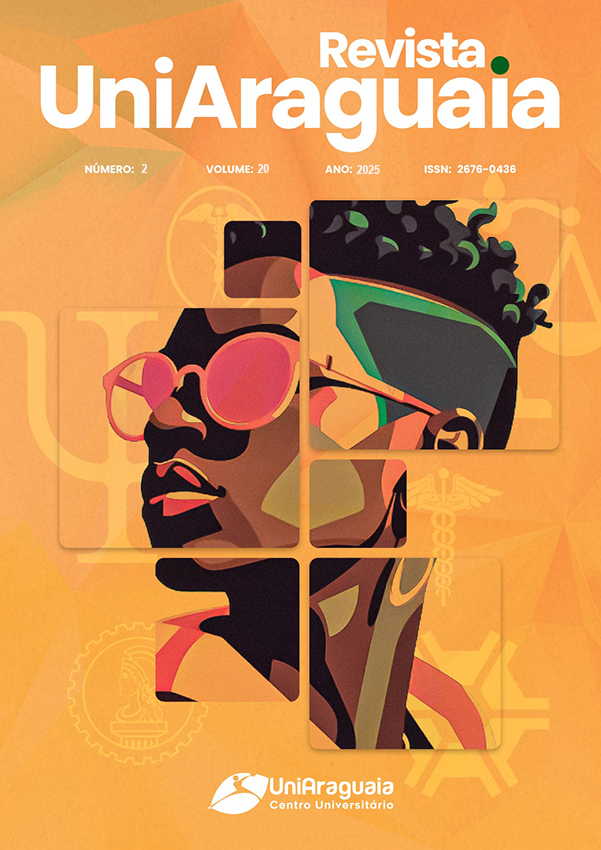TRANSPARÊNCIA AMBIENTAL NO DISTRITO AGROINDUSTRIAL DE ANÁPOLIS
Keywords:
Relatório de Sustentabilidade, Materialidade, ESG, GRIAbstract
Este estudo analisa a transparência ambiental corporativa no Distrito Agroindustrial de Anápolis (DAIA), Goiás, investigando a qualidade e o alinhamento dos relatórios de sustentabilidade com os impactos locais. A pesquisa, baseada em 154 empresas e seus relatórios publicados entre 2020 e 2024, revela um cenário de divulgação seletiva. As empresas priorizam o reporte de temas com forte pressão regulatória ou financeira, como o consumo de água (GRI 303) e as emissões de Gases de Efeito Estufa (GRI 305), enquanto negligenciam impactos locais críticos, como a perda de biodiversidade (GRI 304) e a emissão de poluentes atmosféricos específicos (NOx, SOx). Uma dissonância significativa foi encontrada entre os temas que as empresas declaram como "materiais" em seus discursos e os dados quantitativos que efetivamente publicam, especialmente no setor Químico e Farmacêutico. A principal contribuição metodológica é o Índice de Maturidade de Reporte Ambiental (IMRA), que avalia a qualidade da governança em vez do volume de dados. O IMRA demonstra que a verificação externa é um indicador de compromisso mais robusto do que a quantidade de indicadores reportados, concluindo que a prática de reporte no DAIA, em seu estado atual, funciona mais como uma ferramenta de marketing do que como um mecanismo de prestação de contas genuína.
References
CODEGO, COMPANHIA DE DESENVOLVIMENTO ECONÔMICO DE GOIÁS. Distrito Agroindustrial de Anápolis (DAIA). Goiânia: CODEGO, 2024. Disponível em: https://www.codego.com.br/distritos-industriais/anapolis/. Acesso em: 20 ago. 2024.
CONSEDAIA, CONSELHO EMPRESARIAL PARA PARA O DESENVOLVIMENTO DE ANÁPOLIS (CONSEDAIA). Anuário Quem é Quem no DAIA: 1º Semestre 2024. Anápolis: CONSEDAIA, 2024.
CORREIA, G. M. C.; SIMIONI, C. Políticas ambientais e uma possível mudança na matriz energética da indústria automobilística na Noruega. Caderno da Escola Superior de Gestão Pública, Política, Jurídica e Segurança, Curitiba, v. 4, n. 1, p. 50-64, jan./jun. 2021.
CUNHA, W. C. F. Contexto socioeconômico de Goiás na década de 1970 e a adoção da política de industrialização via distritos industriais. Boletim Goiano de Geografia, Goiânia, v. 30, n. 1, p. 69-92, jan./jun. 2010. DOI: 10.5216/bgg.v30i1.11196.
FOGLIATTI, M. C.; CAMPOS, V. B. G; FERRO, M.A.C; SINAY, L; CRUZ, Sistema de gestão ambiental para empresas. 2. ed. Rio de Janeiro: Interciência, 2024.
FRANCO, F. H. L. Guia técnico sobre as normas de ABS no Brasil: acesso ao patrimônio genético, conhecimento tradicional associado e repartição de benefícios. São Paulo: SINDUSFARMA: GSS Ambiental, 2024. E-book. ISBN 978-85-60162-80-2.
GRI, GLOBAL REPORTING INITIATIVE. Conjunto consolidado das Normas GRI.: Global Reporting Initiative, 2022.
MAZALI, A. Z.; MACHADO, A. R. N. R.; SOUZA, P. A. de. Potencial poluidor das indústrias instaladas no Distrito Agroindustrial de Anápolis (DAIA). 2014. Trabalho de Conclusão de Curso (Especialização em Gestão, Auditoria e Perícia Ambiental) – Faculdade Católica de Anápolis, Anápolis, 2014.
IPCC, PAINEL INTERGOVERNAMENTAL SOBRE MUDANÇAS CLIMÁTICAS. Mudança do Clima 2023: relatório síntese. Brasília, DF: IPCC, 2023. Disponível em: https://www.gov.br/mcti/pt-br/acompanhe-o-mcti/sirene/publicacoes/relatorios-do-ipcc/arquivos/pdf/copy_of_IPCC_Longer_Report_2023_Portugues.pdf. Acesso em: 15 ago. 2024.
PIMENTA, H. C. D.; GOUVINHAS, R. P. Ferramentas de gestão ambiental: competitividade e sustentabilidade. Natal: Editora do CEFET-RN, 2007.
UNIÃO EUROPEIA. Diretiva (UE) 2022/2464 do Parlamento Europeu e do Conselho, de 14 de dezembro de 2022. Jornal Oficial da União Europeia, Luxemburgo, L 322, p. 15-80, 16 dez. 2022. Disponível em: https://eur-lex.europa.eu/legal-content/PT/TXT/PDF/?uri=CELEX:32022L2464.
VILHENA, A. T. de; POLITI, E. (coord.). Reduzindo, reutilizando, reciclando: a indústria ecoeficiente. São Paulo: SENAI-SP Editora, 200
Downloads
Published
Issue
Section
License

This work is licensed under a Creative Commons Attribution 4.0 International License.
The copyright of the published articles will be transferred to the Uniaaraguaia Magazine, allowing its subsequent reproduction as transcription and with due citation of source. In the event of acceptance and before the publication of the article, the plaintiff (s) shall write a statement formally transferring copyright to the magazine.
The author may also print and distribute copies of his article, provided that he mentions that the rights belong to the Uniaaraguaia Magazine.
Author rights include the right to reproduce in full or partly by any means, distribute this article, including figures and photographs.
By submitting originals to the Uniaaraguaia magazine, the author or authors express agreement with the following terms:
a) Authors maintain copyright and grant Uniaraguaia magazine the right of first publication, with the work simultaneously licensed under the Creative Commons Attribution license that allows the sharing of work with recognition of the authorship and initial publication in this magazine.
b) Authors are authorized to assume additional contracts separately, for non-expiration distribution of the work version published in this magazine (eg publish in institutional repository or as book chapter), with recognition of authorship and initial publication in this journal.
c) Authors are allowed and are encouraged to publish and distribute their work online (eg in institutional repositories or on their personal page) to any point before or during the editorial process, as this can generate productive changes as well as increase the impact and citation of published work.

